The electric motor has become a little more well-known and appreciated over the past few years, with its improving integration into automobiles. With most people understanding and appreciating the impact that gasoline pollution has on the climate, there has been a greater demand for auto manufacturers to create cars that can help to improve our environment — or at the very least — do less harm.
It is through this demand for growth and development that some of the world’s greatest inventors have refined the electric motor to now work better and be more efficient than it ever was before.
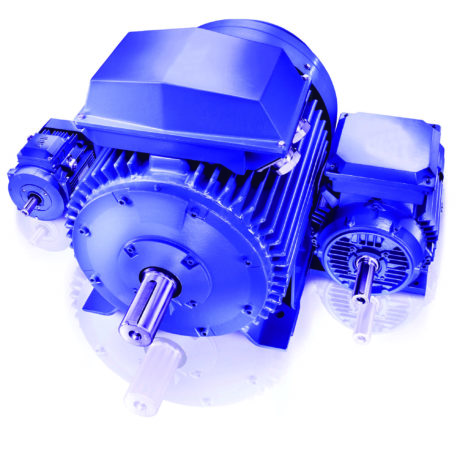
Parts of an Electric Motor
A three-phase, four-pole induction motor is made of two main parts — a stator and a rotor.
Stator. The stator is made of three parts — a stator core, conducting wire, and frame. The stator core is a group of steel rings that are insulated from one another and then laminated together. These rings include slots on their inside that the conducting wire will wrap around to form the stator coils.
Simply put, in a three-phase induction motor, there are three different wire types. You can call these wire types Phase 1, Phase 2, and Phase 3. Each wire type is wrapped around the slots on opposite sides of the inside of the stator core.
Once the conducting wire is in place within the stator core, the core is placed within the frame.
How Does an Electric Motor Work?
If you’re an electrical engineer you know how an electric motor works; if you aren’t, it can be extremely confusing. Therefore, here’s the simplified explanation (or the “how an electric motor works for dummies” version) of how a four-pole, three-phase AC induction motor works in a car.
It starts with the battery in the car that is connected to the motor. Electrical energy is supplied to the stator via the car’s battery. The coils within the stator (made from the conducting wire) are arranged on opposite sides of the stator core and act as magnets, in a way. Therefore, when the electrical energy from the car battery is supplied to the motor, the coils create rotating, magnetic fields that pull the conducting rods
on the outside of the rotor along behind it. The spinning rotor is what creates the mechanical energy needed to turn the gears of the car which, in turn, rotate the tires.
Now in a typical car, i.e., non-electric, there is both an engine and an alternator. The battery powers the engine, which powers the gears and wheels. The rotation of the wheels is what then powers the alternator in the car and the alternator recharges the battery. This is why you are told to drive your car around for a period of time after being jumped — the battery needs to be recharged in order to function appropriately.
There is no alternator in an electric car. So, how does the battery recharge then? While there is no separate alternator, the motor in an electric car acts as both motor and alternator. That’s one of the reasons why electric cars are so unique. As referenced above, the battery starts the motor, which supplies energy to the gears, which rotates the tires. This process happens when your foot is on the accelerator — the rotor gets pulled along by the rotating magnetic field, requiring more torque. But what happens when you let off of the accelerator?
When your foot comes off the accelerator the rotating magnetic field stops and the rotor starts spinning faster (as opposed to being pulled along by the magnetic field). When the rotor spins faster than the rotating magnetic field in the stator, this action recharges the battery, acting as an alternator.
To simplify this process, imagine pedaling a bike up a hill. To get to the top of the hill you need to pedal harder and might even have to stand up and expend more energy to rotate the tires and reach the peak of the hill. This is similar to pressing down on the gas. The rotating magnetic field pulling the rotor behind it creates the resistance (or torque) needed to move the tires and car. Once at the peak of the hill, you can take it easy and recharge while the wheels move even faster to take you down the hill. In the car, this happens when you let your foot off the gas and the rotor moves faster and feeds electrical energy back into the power line to recharge the battery.

What is alternating current (AC) vs. direct current (DC)? The conceptual differences behind these two types of currents should be fairly obvious; while one current (DC) is consistent the other (AC) is more intermittent. However, things are a bit more complicated than just that simple explanation, so let’s break these two terms out in a bit more detail.
Direct current (DC). The term direct current refers to electricity that moves in a singular and consistent direction at all times. Furthermore, a direct current’s voltage maintains a regular polarity; that is, one that does not change.
Think of how batteries have clearly defined positive and negative sides to them. They use direct currents to send the same voltage out on a consistent basis. In addition to batteries, fuel cells and solar cells also produce direct currents, while simple acts like rubbing certain materials together can produce DC as well.
In keeping with our battery concept, when considering the positive and negative sides of the battery, it is important to note that the direct current always flows in the same direction between the positive and negative side. This ensures that both sides of the battery are always positive and negative.
Alternating current (AC). The term alternating current defines a type of electricity characterized by voltage (think water pressure in a hose) and current (think rate of water flow through the hose) that vary with respect to time (Fig. 2). As the voltage and current of an AC signal change, they most often follow the pattern of a sine wave. Due to the waveform being a sine wave, the voltage and current alternate between a positive and negative polarity when viewed over time. The sine wave shape of AC signals is due to the way in which the electricity is generated.
Another term you may hear when discussing AC electricity is frequency. The frequency of the signal is the number of complete wave cycles completed during one second of time. Frequency is measured in Hertz (Hz) and in the United States the standard power-line frequency is 60 Hz. This means that the AC signal oscillates at a rate of 60 complete back-forth cycles every second.
So Why is this Important?
AC electricity is the best way to transfer useable energy from a generation source (i.e., a dam or windmill) over great distances. This is due to the alternating nature of the AC signal that allows the voltage to be easily stepped up or stepped down to different values. This is why your home’s outlets will say 120 volts AC (safer for human consumption) but the voltage of a distribution transformer which supply power to a neighborhood (those cylindrical grey boxes you see on the power line poles), might have voltage as high as 66 kVA (66,000 volts AC).
AC power allows us to construct generators, motors, and distribution systems from electricity that are far more efficient than direct current, which is why AC is the most popular energy current for powering applications.
How Does A Three-Phase, Four-Pole Induction Motor Work?
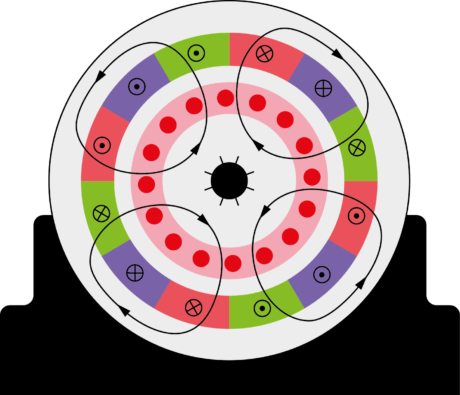
Most large, industrial motors are induction motors and they are used to power diesel trains, dishwashers, fans, and countless other things. But what exactly does an “induction” motor mean? In technical terms it means that the stator windings induce a current to flow into the rotor conductors. In layman’s terms, this means that the motor is started because electricity is induced into the rotor by magnetic currents instead of a direct connection to electricity, like other motors such as a DC commutator motor.
What does polyphase mean? Whenever you have a stator that houses multiple, unique windings per motor pole, you are dealing with polyphase (Fig. 3). It is most common to expect a polyphase motor to be made up of three phases, but there are motors that utilize two phases.
A polyphase system uses multiple voltages to phase-shift apart from each one in order to go intentionally out of line.
What does three phase mean? Based around Nikola Tesla’s basic principles defined in his polyphase induction motor put forth in 1883, “three phase” refers to the electrical energy currents that are supplied to the stator via the car’s battery (Fig. 4). This energy causes the conducting wire coils to start to behave like electromagnets.
A simple way to understand three phase is to consider three cylinders, shaped in a Y formation, utilizing energy pointed toward the center point to generate power. As the energy is created, the current flows into the coil pairs inside the engine in such a way that it naturally creates a north and south pole within the coils, allowing them to act like opposite sides of a magnet.
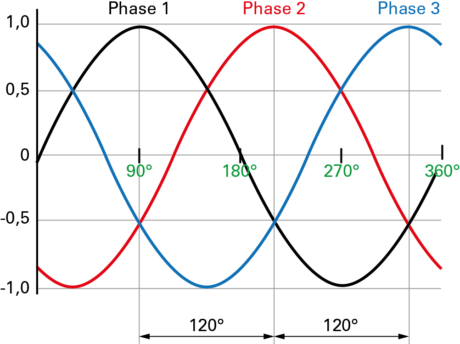
Top Performing Electric Cars
As this technology continues to advance, the performance of electric cars are starting to quickly catch up to, and even outperform, their gas counterparts. While there remains some distance for electric cars to go, the leaps that companies like Tesla and Toyota have made to this point have inspired hope that the future of transportation will no longer be reliant on fossil fuels.
At this point, we all know the success that Tesla is experiencing in the field, putting out the Tesla Model S Sedan that is capable of driving up to 288 miles, hitting 155 MPH, and has 687 lb-ft torque. However, there are dozens of other companies that are seeing massive progress in the field, such as Ford’s Fusion Hybrid, Toyota’s Prius and Camry-Hybrid, Mitsubishi’s iMiEV, Ford’s Focus, BMW’s i3, Chevy’s Spark, and Mercedes’ B-Class Electric (Fig. 5).
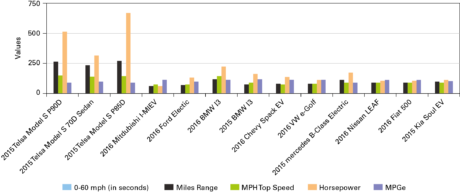
Electric Cars and the Environment
Electric engines impact the environment both directly and indirectly at a micro and macro level. It depends on how you want to perceive the situation and how much energy you want. From the individual standpoint, electric cars don’t require gasoline to run, which leads to cars with no emissions populating our highways and cities. While this presents a new problem with additional burden of electricity production, it alleviates the strain from millions of cars densely populating cities and suburbs putting toxins into the air (Fig. 6).
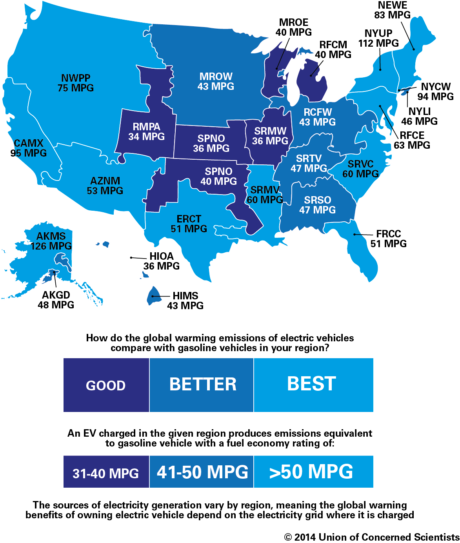
Note: The MPG (miles per gallon values listed for each region is the combined city/highway fuel economy rating of a gasoline vehicle that would have global warmings equivalent to driving an EV. Regional global warming emissions ratings are based on 2012 power plant data in the EPA’s eGrid 2015 database. Comparisons include gasoline and electricity fuel production emissions. The 58 MPG U.S. average is a sales-weighted average based on where EV’s were sold in 2014.
From a large-scale perspective, there are several benefits to the rise of electric cars. For starters, there is a reduction in noise pollution as the noise emitted from an electric engine is far more subdued than that of a gas powered engine. In addition, due to the fact that electric engines do not require the same type of lubricants and maintenance that a gas engine does, the chemicals and oils used at auto-shops will be reduced due to fewer cars needing check-ups.
Conclusions
The electric engine is changing the course of history in the same way that the steam powered engine and printing press redefined progress. While the electric engine is not paving new grounds in the same vein as these inventions, it is opening up a brand new segment of the transportation industry. That is not only focused on style and performance, but also external impact. So, while the electric engine may not be reforming the world due to an introduction of some brand new invention or the creation of a new marketplace, it is redefining how we as a society define progress.
If nothing else is to come from the advancements with the electric engine, at the very least we can say that our society has moved forward with our awareness of our environmental impact. This is the new definition of progress, as defined by the electric engine.
References
- www.allaboutcircuits.com/textbook/alternating-current/chpt-13/tesla-polyphase-induction-motors. Construction of Three Phase Induction Motor www.youtube.com/watch?v=Mle-ZvYi8HA How does an induction motor work? www.youtube.com/watch?v=LtJoJBUSe28
- www.mpoweruk.com/motorsbrushless.htm
- www.kerryr.net/pioneers/tesla.htm
- www.basilnetworks.com/article/motors/brushlessmotors.htm
- www.allaboutcircuits.com/textbook/alternating-current/chpt-13/tesla-polyphase-induction-motors
- www.youtube.com/watch?v=HWrNzUCjbkk
- Working Principal of Three Phase Induction Motor www.youtube.com/watch?v=DsVbaKZZOFQ
- www.youtube.com/watch?v=NaV7V07tEMQ
- www.teslamotors.com/models
- http://evobsession.com/electric-car-range-comparison
- www.edmunds.com/mitsubishi/i-miev/2016/review
- www.ford.com/cars/focus/trim/electric
- https://en.wikipedia.org/wiki/BMW_i3
- www.edmunds.com/ford/fusion-energi/2016/review
- www.chevrolet.com/spark-ev-electric-vehicle.html
- www.topspeed.com/cars/volkswagen/2016-volkswagen-e-golf-limited-edition-ar168067.html
- www.topspeed.com/cars/bmw/2016-bmw-i3-m-ar160295.html
- www.popularmechanics.com/cars/hybrid-electric/reviews/a9756/2015-mercedes-benz-b-class-electric-drive-test-ride-16198208
- www.topspeed.com/cars/nissan/2016-nissan-leaf-ar171170.html
- www.caranddriver.com/fiat/500e
- www.topspeed.com/cars/kia/2015-kia-soul-electricdriven-ar170088.html
- www.topspeed.com/cars/ford/2016-ford-focus-electric-ar171335.html
- www.topspeed.com/cars/tesla/2015-tesla-model-s-70d-ar168705.html
- www.topspeed.com/cars/tesla/2015-tesla-model-s-p85d-ar165627.html
- www.topspeed.com/cars/tesla/2015-tesla-model-s-ar165742.html#main
- www.caranddriver.com/reviews/2015-tesla-model-s-p90d-test-review
- www.caranddriver.com/tesla/model-s
- www.allaboutcircuits.com/textbook/alternating-current/chpt-1/what-is-alternating-current-ac
- http://science.howstuffworks.com/electricity8.htm
- www.allaboutcircuits.com/textbook/alternating-current/chpt-13/tesla-polyphase-induction-motors
- Image from: http://faq.zoltenergy.co/technical
- www.kerryr.net/pioneers/tesla.htm
- https://en.wikipedia.org/wiki/Westinghouse_Electric_(1886)
- www.allaboutcircuits.com/textbook/alternating-current/chpt-13/introduction-ac-motors
- www.youtube.com/watch?v=Q2mShGuG4RY
- www.explainthatstuff.com/electricmotors.html
- http://electronics.howstuffworks.com/motor.htm
- https://en.wikipedia.org/wiki/Induction_motor

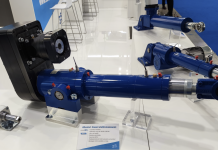
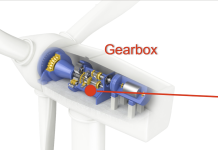
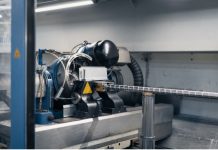
Electric cars are the future of automotive industry. The environmental problem created by diesel and petrol cars are difficult to repair. It is the need of the hour to switch for environmentally friendly vehicles. A thought for future generation benefits. We should sacrifice our comfort to facilitate future generation. Bhutan is the country, which has 72 percent of its area under forest and It gives special attention towards the greener world. Their majority transport system relies on the electrical vehicle.
Electric Motor Work? online
The endeavors are utilizing different sorts of circle turning machine as appeared by their necessities. Transformer winding machine is the more standard sort and it having the structure in even and vertical shapes. Smash the most bit of standard paying little respect to winding machine is utilized for turn bowing transformer with rise device.toroidal winding
It was interesting when you talked about how the sine wave nature of AC current causes the voltage and current to change back and forth between a positive and negative polarity. The company I work for has some large equipment in need of repairs, including our AC electrical engine and gearbox. Thanks for helping me feel prepared to talk with a repair service about the issue!
The following blog is really comprehensive and informational I have been facing an concurrent issue of the dry condenser coils and the fan problems in ac.Suggest us what to include regarding the improvement of https://handyman-dubai.com/ac-repair-dubai .
Thanks for explaining that the three different wire types in electric motors are wrapped around slots inside the stator core. My brother is looking for a bearing repair service to help him get the electric motor in his manufacturing plant functioning efficiently again. I’ll pass along this info since it could be helpful for him to understand how electric motors work!